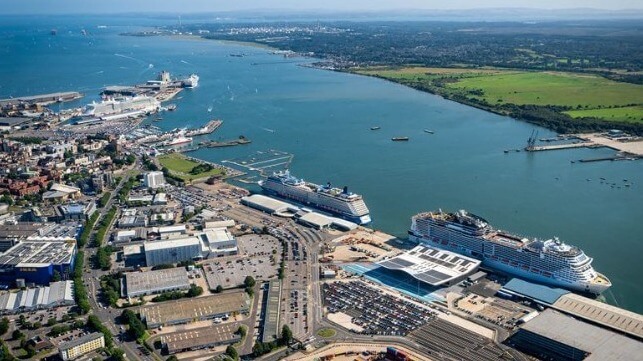Op-Ed: Port Call Optimization Should be on the Wishlist This Season

Port calls represent a major opportunity for optimization. A study on container ships, conducted by Wärtsilä Voyage, found that on average vessels spent around 6 percent of their time - that’s 22 days a year - waiting at anchorage for a berth. This results in extra fuel consumption, higher emissions, and congested ports.
This opportunity is not limited to container ships. In fact, the international merchant fleet of 50,000+ ships and the world’s 250 large ports, as well as the thousands of smaller local operations, can significantly benefit from digital technologies. A 2022 decarbonization report by Inmarsat, for example, found that deploying modern digital technologies could help to reduce maritime emissions by up to 38 percent by 2050.
Every drop of fuel counts
Burning carbon-intense fuels is the biggest contributor to the maritime industry’s 940 million tonnes of annual CO2 emissions. Therefore, it should go without saying that ship operators should not, in any circumstances, waste fuel. Yet fuel inefficiency remains one of the largest sources of waste in shipping which must be addressed.
The Wärtsilä team, for example, are investing heavily in R&D and developing solutions that help to tackle this issue, focussing on technologies such as fuel performance monitoring, vessel optimization and future fuels. In addition, it believes there are some significant opportunities to improve the efficiency of vessel and port operations.
Looking beyond carbon to cash, although the two are increasingly interlinked, the team found that fuel comprises 43 percent of total voyage costs and about 40 percent of a ship’s annual operating expenditure (OPEX).
The solution is to invest in digital technologies which enhance vessel, operational and port efficiency. Enabling Just-in-Time (JIT) arrivals, for example, can cut container shipping emissions per voyage by 14 percent, according to a 2022 report from the IMO-Norway Green Voyage 2050 project. Arriving just in time means lower OPEX and reduced emissions for both port and ship operators.
Just-in-Time
While the concept of JIT arrivals has been around for decades, the reality is that they have not yet been consistently achieved across the maritime industry and there has been no established procedure to share the benefits of JIT operations among all the stakeholders involved in a voyage – until now.
The benefits of JIT arrivals extend beyond lower costs and reduced emissions. JIT arrivals can also reduce congestion and delays in ports – improving the safety, competitiveness, and resilience of maritime operations. This, in turn, improves the standing of, and demand for, maritime operations within global supply chains, to account for seasonal peaks and troughs, from Black Friday and Christmas to midsummer.
Port management information systems, as well as advanced vessel and voyage optimization platforms, use the latest developments in Artificial Intelligence (AI) and machine learning to enable JIT operations and unlock all the aforementioned benefits. So, what’s holding the industry back from consistently making JIT arrivals a reality?
Fragmented digital ecosystem
The maritime industry’s growing and increasingly complex digital ecosystem is a major barrier to unlocking the benefits of JIT operations. Each stakeholder often relies on different complicated, fragmented solutions that do not share the relevant data with each other and which still require a significant amount of manual, often duplicated, intervention to properly leverage.
The solution here is to break down data silos and ensure that information can be used effectively by counterparties, be it cargo owners and charterers, ports, or other actors in the global supply chain. Investing in holistic digital solutions that are integrated and interoperable across the entire vessel and port ecosystem is key, and the good news is, there are holistic solutions on the market today.
Progress on barriers
There are other contract and regulatory barriers that have been holding JIT arrivals back too. Initially, JIT operations can seem to go against the common requirement in a voyage charter for a ship to proceed with ‘reasonable dispatch’ to a port and, on arrival, give a ‘notice of readiness’ to mark the start of its period of hire. This can sometimes result in demurrage payments while waiting to load that exceed the cost of burning excess fuel to arrive early.
Many shipping bodies have realized the need to overcome this barrier and see smart port technology as playing a key role. BIMCO, for example, published a Just-in-time arrival clause in February 2021 for voyage charters. This provides for a payment by a charterer to a ship’s owner to compensate for the extra time on the voyage. The expectation is that this clause will increase in importance as more companies are driven to decarbonize as the global energy transition continues and, hopefully, picks up pace.
The bottom line is that the barriers to optimized port calls and, specifically, consistent JIT arrivals are being overcome and the benefits – most importantly cost and emissions reductions – are hard to ignore as the maritime industry decarbonizes. More broadly, ship and port operators are increasingly waking up to the need to make major operational efficiency improvements to decarbonize and remain competitive. These major maritime players are also recognizing the role of smart, digital technology in this journey – which is positive progress to see.
Bruce Mills is Business Development Lead – Ports at Wärtsilä Voyage. Much of his work, and indeed Wärtsilä Voyage’s technology is focused on solving inefficiencies and unlocking efficiencies in the maritime industry.
The opinions expressed herein are the author's and not necessarily those of The Maritime Executive.
